Sentinel-2 Data in an Evaluation of the Impact of the Disturbances on Forest Vegetation
Abstract
:1. Introduction
- To test the Sentinel-2 data in the TS analyses for the selected case studies in Czechia and Slovakia within a three-year period of 2017–2019 and to evaluate the benefits of the Sentinel-2 data for monitoring the forest changes.
- To compare the Sentinel-2 and Landsat temporal and spatial resolution for the TS analyses of the forest vegetation in mountainous areas.
- To evaluate the relevancy of the vegetation indices in the study of the forest changes and the health of the forest vegetation using the Sentinel-2 data.
- To perform TS analyses and compare the results in the different types of areas affected by the bark beetle invasion (the disturbed and renewing forest ecosystems).
- To discuss the positives and perspectives of the Sentinel-2 data in the TS of forest changes in comparison to the traditional data used, e.g., Landsat.
- To process the satellite data and perform analyses in the cloud-based tool (Sentinel Hub) and discuss the positives and negatives of cloud-based systems for end-users in forestry research and management.
- What are the main positives of the Sentinel-2 data in the evaluation of the forest vegetation affected by the disturbances? What type of change in the forest is possible to detect by Sentinel-2? What are the positives using Sentinel-2 data in the TS in comparison with the traditional satellite data, e.g., Landsat?
- What are the positives of processing and analyzing the data in a cloud-based tool (Sentinel Hub)?
- What vegetation indices derived from the bands of the Sentinel-2 data are useful for the detection of the forest affected by a bark beetle invasion? Which vegetation indices based on these data could detect the disturbances that occurred and individual recovery phases in the forest of mountainous areas? Are the vegetation indices, traditionally used for Landsat data, usable for the Sentinel-2 data?
- How many cloud-free images of Sentinel-2 are available for the TS analysis in our mountainous areas case studies annually? What is the progress of the data availability per year in comparison with the Landsat data? Is the temporal resolution of the Sentinel-2 data sufficient to detect the changes and the health of the forest within the year?
2. Materials and Methods
2.1. Study Areas
2.1.1. In Situ and Auxiliary Data
2.1.2. Study Area Description
2.2. Optical Data
2.2.1. Sentinel-2
2.2.2. Landsat 8
2.3. Data Processing
2.3.1. Evaluation of the Spatial and Temporal Resolution
2.3.2. TS Analysis
3. Results
3.1. Comparison of the Spatial and Temporal Resolution of Sentinel-2 and Landsat 8
3.2. Time Series of the Vegetation Indices Using Sentinel-2 Data
3.2.1. NDVI Time Series
3.2.2. NDMI Time Series
3.2.3. Tasseled Cap Greenness (TCG) Time Series
3.2.4. Tasseled Cap Wetness (TCW) Time Series
3.2.5. Statistical Analyses
4. Discussion
5. Conclusions
Author Contributions
Funding
Acknowledgments
Conflicts of Interest
Appendix A
| Mission | Radiometric Resolution | Temporal Resolution | Spectral Band | Coastal/Aerosol (B01) | Blue (B02) | Green (B03) | Red (B04) | NIR 2 (B05) | NIR 3 (B06) | NIR 4 (B07) | NIR 1 (B08) | NIR 5 (B8A) | Atmospheric/Water Vapour (B09) | Cirrus (B10) | SWIR 1 (B11) | SWIR 2 (B12) | Panchromatic | Thermal Infrared 1 | Thermal Infrared 2 | Date |
|---|---|---|---|---|---|---|---|---|---|---|---|---|---|---|---|---|---|---|---|---|
| Landsat 4 and 5 | 8bit (16bit rescaled) | 16 days | Central Wavelength (nm) | - | 485 | 560 | 660 | - | - | - | 830 | - | - | - | 1650 | 2215 | - | 11450 | - | 16 July 1982 (deactivated: 15 June 2001)/1 March 1984 (deactivated: 5 June 2013) |
| Bandwidth (nm) | - | 70 | 80 | 60 | - | - | - | 140 | - | - | - | 200 | 270 | - | 2100 | - | ||||
| Spatial Resolution (m) | - | 30 | 30 | 30 | - | - | - | 30 | - | - | - | 30 | 30 | - | 120 | - | ||||
| Landsat 7 | Central Wavelength (nm) | - | 485 | 560 | 660 | - | - | - | 835 | - | - | - | 1650 | 2215 | 710 | 11450 | - | 15 April 1999 (active, data failure: 31 May 2003) | ||
| Bandwidth (nm) | - | 70 | 80 | 60 | - | - | - | 130 | - | - | - | 200 | 270 | 380 | 2100 | - | ||||
| Spatial Resolution (m) | - | 30 | 30 | 30 | - | - | - | 30 | - | - | - | 30 | 30 | 15 | 60 | - | ||||
| Landsat 8 | 12bit (16bit rescaled) | Central Wavelength (nm) | 440 | 480 | 560 | 655 | - | - | - | 865 | - | - | 1370 | 1610 | 2200 | 590 | 10895 | 12005 | 11 February 2013 (active) | |
| Bandwidth (nm) | 20 | 60 | 60 | 30 | - | - | - | 30 | - | - | 20 | 80 | 180 | 180 | 590 | 1010 | ||||
| Spatial Resolution (m) | 30 | 30 | 30 | 30 | - | - | - | 30 | - | - | 30 | 30 | 30 | 15 | 100 | 100 | ||||
| Sentinel-2A | 12-bit | 10-day (5-day with both satellites) | Central Wavelength (nm) | 443.9 | 496.6 | 560 | 664.5 | 703.9 | 740.2 | 782.5 | 835.1 | 864.8 | 945 | 1373.5 | 1613.7 | 2202.4 | - | - | - | 23 June 2015 (active) |
| Bandwidth (nm) | 27 | 98 | 45 | 38 | 19 | 18 | 28 | 145 | 33 | 26 | 75 | 143 | 242 | - | - | - | ||||
| Spatial Resolution (m) | 60 | 10 | 10 | 10 | 20 | 20 | 20 | 10 | 20 | 60 | 60 | 20 | 20 | - | - | - | ||||
| Sentinel-2B | Central Wavelength (nm) | 442.3 | 492.1 | 559 | 665 | 703.8 | 739.1 | 779.7 | 833 | 864 | 943.2 | 1376.9 | 1610.4 | 2185.7 | - | - | - | 7 March 2017 (active) | ||
| Bandwidth (nm) | 45 | 98 | 46 | 39 | 20 | 18 | 28 | 133 | 32 | 27 | 76 | 141 | 238 | - | - | - | ||||
| Spatial Resolution (m) | 60 | 10 | 10 | 10 | 20 | 20 | 20 | 10 | 20 | 60 | 60 | 20 | 20 | - | - | - |
References
- Wulder, M.A.; Masek, J.G.; Cohen, W.B.; Loveland, T.R.; Woodcock, C.E. Opening the archive: How free data has enabled the science and monitoring promise of Landsat. Remote Sens. Environ. 2012, 122, 2–10. [Google Scholar] [CrossRef]
- Abdullah, H.; Skidmore, A.K.; Darvishzadeh, R.; Heurich, M. Sentinel-2 accurately maps green-attack stage of European spruce bark beetle (Ips typographus, L.) compared with Landsat-8. Remote Sens. Ecol. Conserv. 2019, 5, 87–106. [Google Scholar] [CrossRef] [Green Version]
- Hansen, M.C.; Stehman, S.V.; Potapov, P.V. Quantification of global gross forest cover loss. Proc. Natl. Acad. Sci. USA 2010, 107, 8650–8655. [Google Scholar] [CrossRef] [PubMed] [Green Version]
- Potapov, P.V.; Turubanova, S.A.; Tyukavina, A.; Krylov, A.M.; McCarty, J.L.; Radeloff, V.C.; Hansen, M.C. Eastern Europe’s forest cover dynamics from 1985 to 2012 quantified from the full Landsat archive. Remote Sens. Environ. 2015, 159, 28–43. [Google Scholar] [CrossRef]
- Pflugmacher, D.; Cohen, W.B.; Kennedy, R.E. Using Landsat-derived disturbance history (1972–2010) to predict current forest structure. Remote Sens. Environ. 2012, 122, 146–165. [Google Scholar] [CrossRef]
- Zhu, Z.; Woodcock, C.E. Object-based cloud and cloud shadow detection in Landsat imagery. Remote Sens. Environ. 2012, 118, 83–94. [Google Scholar] [CrossRef]
- Zhu, Z.; Woodcock, C.E. Continuous change detection and classification of land cover using all available Landsat data. Remote Sens. Environ. 2014, 144, 152–171. [Google Scholar] [CrossRef] [Green Version]
- Zhu, Z.; Woodcock, C.E.; Holden, C.; Yang, Z. Generating synthetic Landsat images based on all available Landsat data: Predicting Landsat surface reflectance at any given time. Remote Sens. Environ. 2015, 162, 67–83. [Google Scholar] [CrossRef]
- Neigh, C.S.R.; Bolton, D.K.; Diabate, M.; Williams, J.J.; Carvalhais, N. An Automated Approach to Map the History of Forest Disturbance from Insect Mortality and Harvest with Landsat Time-Series Data. Remote Sens. 2014, 6, 2782–2808. [Google Scholar] [CrossRef] [Green Version]
- DeRose, R.J.; Long, J.N.; Ramsey, R.D. Combining dendrochronological data and the disturbance index to assess Engelmann spruce mortality caused by a spruce beetle outbreak in southern Utah, USA. Remote Sens. Environ. 2011, 115, 2342–2349. [Google Scholar] [CrossRef]
- Hicke, J.A.; Logan, J. Mapping whitebark pine mortality caused by a mountain pine beetle outbreak with high spatial resolution satellite imagery. Int. J. Remote Sens. 2009, 30, 4427–4441. [Google Scholar] [CrossRef]
- Jin, S.; Sader, S.A. Comparison of time series tasseled cap wetness and the normalized difference moisture index in detecting forest disturbances. Remote Sens. Environ. 2005, 94, 364–372. [Google Scholar] [CrossRef]
- Griffiths, P.; Kuemmerle, T.; Baumann, M.; Radeloff, V.C.; Abrudan, I.V.; Lieskovsky, J.; Munteanu, C.; Ostapowicz, K.; Hostert, P. Forest disturbances, forest recovery, and changes in forest types across the Carpathian ecoregion from 1985 to 2010 based on Landsat image composites. Remote Sens. Environ. 2014, 151, 72–88. [Google Scholar] [CrossRef]
- Kozak, J.; Estreguil, C.; Troll, M. Forest cover changes in the northern Carpathians in the 20th century: A slow transition. J. Land. Use Sci. 2007, 2, 127–146. [Google Scholar] [CrossRef]
- Kuemmerle, T.; Hostert, P.; Radeloff, V.C.; Perzanowski, K.; Kruhlov, I. Post-Socialist Forest Disturbance in the Carpathian Border Region of Poland, Slovakia, and Ukraine. Ecol. Appl. 2007, 17, 1279–1295. [Google Scholar] [CrossRef] [PubMed]
- Butsic, V.; Munteanu, C.; Griffiths, P.; Knorn, J.; Radeloff, V.C.; Lieskovský, J.; Mueller, D.; Kuemmerle, T. The effect of protected areas on forest disturbance in the Carpathian Mountains 1985–2010. Conserv. Biol. 2017, 31, 570–580. [Google Scholar] [CrossRef] [PubMed]
- Kupkova, L.; Potuckova, M.; Lhotakova, Z.; Albrechtova, J. Forest cover and disturbance changes, and their driving forces: A case study in the Ore Mountains, Czechia, heavily affected by anthropogenic acidic pollution in the second half of the 20th century. Environ. Res. Lett. 2018, 13. [Google Scholar] [CrossRef]
- Hais, M.; Wild, J.; Berec, L.; Bruna, J.; Kennedy, R.; Braaten, J.; Broz, Z. Landsat imagery spectral trajectories-important variables for spatially predicting the risks of bark beetle disturbance. Remote Sens. 2016, 8, 687. [Google Scholar] [CrossRef] [Green Version]
- Hais, M.; Jonasová, M.; Langhammer, J.; Kucera, T. Comparison of two types of forest disturbance using multitemporal Landsat TM/ETM+ imagery and field vegetation data. Remote Sens. Environ. 2009, 113, 835–845. [Google Scholar] [CrossRef]
- Stych, P.; Lastovicka, J.; Hladky, R.; Paluba, D. Evaluation of the Influence of Disturbances on Forest Vegetation Using the Time Series of Landsat Data: A Comparison Study of the Low Tatras and Sumava National Parks. ISPRS Int. J. Geo-Inf. 2019, 8, 71. [Google Scholar] [CrossRef] [Green Version]
- Stych, P.; Jerabkova, B.; Lastovicka, J.; Riedl, M.; Paluba, D. A Comparison of Worldview-2 and Landsat 8 Images for the Classification of Forests Affected by Bark Beetle Outbreaks Using a Support Vector Machine and a Neural Network: A Case Study in the Sumava Mountains. Geosciences 2019, 9, 396. [Google Scholar] [CrossRef] [Green Version]
- Jensen, J.R. Remote Sensing of the Environment: An Earth Resource Perspective, 2nd ed.; Pearson Prentice Hall: Upper Saddle River, NJ, USA, 2007. [Google Scholar]
- Rouse, J.W.; Haas, R.H.; Schell, J.A.; Deering, D.W. Monitoring vegetation systems in the Great Plains with ERTS. In Proceedings of the 3rd ERTS Symposium, Washington, DC, USA, 10–14 December 1973; NASA SP-351 I. pp. 309–317. [Google Scholar]
- Wang, J.; Sammis, T.W.; Gutschick, V.P.; Gebremichael, M.; Dennis, S.O.; Harrison, R.E. Review of Satellite Remote Sensing Use in Forest Health Studies. Open Geogr. J. 2010, 3, 28–42. [Google Scholar] [CrossRef]
- Gao, B. NDWI—A normalized difference water index for R. Elsevier 1996, 266, 257–266. [Google Scholar] [CrossRef]
- Vogelmann, J.E.; Xian, G.; Homer, C.; Tolk, B. Monitoring gradual ecosystem change using Landsat time series analyses: Case studies in selected forest and rangeland ecosystems. Remote Sens. Environ. 2012, 122, 92–105. [Google Scholar] [CrossRef] [Green Version]
- Deering, D.; Rouse, J. Measuring ‘Forage Production’ of Grazing Units from Landsat MSS Data. In Proceedings of the 10th International Symposium on Remote Sensing of Environment, ERIM, Ann Arbor, MI, USA, 6–10 October 1975; pp. 1169–1178. [Google Scholar]
- Hladky, R.; Lastovicka, J.; Holman, L.; Stych, P. Evaluation of the influence of disturbances on forest vegetation using Landsat time series; a case study of the Low Tatras National Park. Eur. J. Remote Sens. 2020, 53, 40–66. [Google Scholar] [CrossRef] [Green Version]
- Vogeler, J.C.; Braaten, J.D.; Slesak, R.A.; Falkowski, M.J. Extracting the full value of the Landsat archive: Inter-sensor harmonization for the mapping of Minnesota forest canopy cover (1973–2015). Remote Sens. Environ. 2018, 209, 363–374. [Google Scholar] [CrossRef]
- Wulder, M.A.; White, J.C.; Loveland, T.R.; Woodcock, C.E.; Belward, A.S.; Cohen, W.B.; Fosnight, E.A.; Shaw, J.; Masek, J.G.; Roy, D.P. The global Landsat archive: Status, consolidation, and direction. Remote Sens. Environ. 2016, 185, 271–283. [Google Scholar] [CrossRef] [Green Version]
- Franklin, S.E.; Wulder, M.A.; Skakun, R.S.; Carroll, A.L. Mountain pine beetle red-attack forest damage classification using stratified Landsat TM data in British Columbia, Canada. Photogramm. Eng. Remote Sens. 2003, 69, 283–288. [Google Scholar]
- Li, F.; Jupp, D.L.B.; Paget, M.; Briggs, P.R.; Thankappan, M.; Lewis, A.; Held, A. Improving BRDF normalisation for Landsat data using statistical relationships between MODIS BRDF shape and vegetation structure in the Australian continent. Remote Sens. Environ. 2017, 195, 275–296. [Google Scholar] [CrossRef]
- Roy, D.P.; Kovalskyy, V.; Zhang, H.K.; Vermote, E.F.; Yan, L.; Kumar, S.S.; Egorov, A. Characterization of Landsat-7 to Landsat-8 reflective wavelength and normalized difference vegetation index continuity. Remote Sens. Environ. 2016, 185, 57–70. [Google Scholar] [CrossRef] [Green Version]
- Immitzer, M.; Vuolo, F.; Atzberger, C. First Experience with Sentinel-2 Data for Crop and Tree Species Classifications in Central Europe. Remote Sens. 2016, 8, 166. [Google Scholar] [CrossRef]
- Rapinel, S.; Mony, C.; Lecoq, L.; Clément, B.; Thomas, A.; Hubert-Moy, L. Evaluation of Sentinel-2 time-series for mapping floodplain grassland plant communities. Remote Sens. Environ. 2019, 223, 115–129. [Google Scholar] [CrossRef]
- Lambert, M.J.; Traoré, P.C.S.; Blaes, X.; Baret, P.; Defourny, P. Estimating smallholder crops production at village level from Sentinel-2 time series in Mali’s cotton belt. Remote Sens. Environ. 2018, 216, 647–657. [Google Scholar] [CrossRef]
- Piedelobo, L.; Hernández-López, D.; Ballesteros, R.; Chakhar, A.; Del Pozo, S.; González-Aguilera, D.; Moreno, M.A. Scalable pixel-based crop classification combining Sentinel-2 and Landsat-8 data time series: Case study of the Duero river basin. Agric. Syst. 2019, 171, 36–50. [Google Scholar] [CrossRef]
- Ottosen, T.B.; Lommen, S.T.E.; Skjøth, C.A. Remote sensing of cropping practice in Northern Italy using time-series from Sentinel-2. Comput. Electron. Agric. 2019, 157, 232–238. [Google Scholar] [CrossRef] [Green Version]
- Rozenstein, O.; Haymann, N.; Kaplan, G.; Tanny, J. Estimating cotton water consumption using a time series of Sentinel-2 imagery. Agric. Water Manag. 2018, 207, 44–52. [Google Scholar] [CrossRef]
- Shang, R.; Zhu, Z. Harmonizing Landsat 8 and Sentinel-2: A time-series-based reflectance adjustment approach. Remote Sens. Environ. 2019, 235, 111439. [Google Scholar] [CrossRef]
- Masek, J.; Claverie, M.; Dungan, J.; Ju, J. Harmonized Landsat-8 and Sentinel-2. In User Guide; 2017. Available online: https://hls.gsfc.nasa.gov/wp-content/uploads/2017/08/HLS.v1.3.UserGuide_v2.pdf (accessed on 8 June 2020).
- Shao, Z.; Cai, J.; Fu, P.; Hu, L.; Liu, T. Deep learning-based fusion of Landsat-8 and Sentinel-2 images for a harmonized surface reflectance product. Remote Sens. Environ. 2019, 235, 111425. [Google Scholar] [CrossRef]
- Navarro, A.; Catalao, J.; Calvao, J. Assessing the Use of Sentinel-2 Time Series Data for Monitoring Cork Oak Decline in Portugal. Remote Sens. 2019, 11, 2515. [Google Scholar] [CrossRef] [Green Version]
- Li, L.; Li, N.; Lu, D.; Chen, Y. Mapping Moso bamboo forest and its on-year and off-year distribution in a subtropical region using time-series Sentinel-2 and Landsat 8 data. Remote Sens. Environ. 2019, 231, 111265. [Google Scholar] [CrossRef]
- Grabska, E.; Hostert, P.; Pflugmacher, D.; Ostapowicz, K. Forest Stand Species Mapping Using the Sentinel-2 Time Series. Remote Sens. 2019, 11, 1197. [Google Scholar] [CrossRef] [Green Version]
- Gomes, V.C.F.; Queiroz, G.R.; Ferreira, K.R. An Overview of Platforms for Big Earth Observation Data Management and Analysis. Remote Sens. 2020, 12, 1253. [Google Scholar] [CrossRef] [Green Version]
- Sovdat, B.; Kadunc, M.; Batic, M.; Milcinski, G.; Functions, P.L. Natural color representation of Sentinel-2 data. Remote Sens. Environ. 2017, 225, 392–402. [Google Scholar] [CrossRef]
- Albrechtova, J.; Kupkova, L.; Campbell, P.K.E. Hodnoceni Stavu Smrkovych Porostu.-Pripadove Studie Sledovani Vyvoje Fyziologickeho Stavu Smrkovych Porostu v Krusnych Horach v Letech 1998–2013; Geographica-Česká Geografická Společnost: Nové Město, Czechia, 2017; ISBN ISBN 978-80-905642-9-9. [Google Scholar]
- Hais, M.; Kucera, T. The influence of topography on the forest surface temperature retrieved from Landsat TM, ETM + and ASTER thermal channels. ISPRS J. Photogramm. Remote Sens. 2009, 64, 585–591. [Google Scholar] [CrossRef]
- Tang, D.; Fan, H.; Yang, K.; Zhang, Y. Mapping forest disturbance across the China–Laos border using annual Landsat time series. Int. J. Remote Sens. 2019, 40, 2895–2915. [Google Scholar] [CrossRef]
- Schultz, M.; Clevers, J.G.P.W.; Carter, S.; Verbesselt, J.; Avitabile, V.; Quang, H.V.; Herold, M. Performance of vegetation indices from Landsat time series in deforestation monitoring. Int. J. Appl. Earth Obs. Geoinf. 2016, 52, 318–327. [Google Scholar] [CrossRef]
- Rouse, J.W.; Haas, R.H.; Schell, J.A.; Deering, D.W. Monitoring the Vernal Advancement and Retrogradation (Green Wave Effect) of Natural Vegetation; Remote Sens. Centre, TEXAS A&M Univ.: College Station, TX, USA, 1973. [Google Scholar]
- Xiao, C.; Li, P.; Feng, Z. Monitoring annual dynamics of mature rubber plantations in Xishuangbanna during 1987-2018 using Landsat time series data: A multiple normalization approach. Int. J. Appl. Earth Obs. Geoinf. 2019, 77, 30–41. [Google Scholar] [CrossRef]
- Purwadi, I.; Van Der Werff, H.M.A.; Lievens, C. Targeting rare earth element bearing mine tailings on Bangka Island, Indonesia, with Sentinel-2 MSI. Int. J. Appl. Earth Obs. Geoinf. 2020, 88, 1–8. [Google Scholar] [CrossRef]
- Rujoiu-Mare, M.R.; Olariu, B.; Mihai, B.A.; Nistor, C.; Savulescu, I. Land cover classification in Romanian Carpathians and Subcarpathians using multi-date Sentinel-2 remote sensing imagery. Eur. J. Remote Sens. 2017, 50, 496–508. [Google Scholar] [CrossRef] [Green Version]
- Kauth, R.J.; Thomas, G.S. The Tasselled Cap -- A Graphic Description of the Spectral-temporal Development of Agricultural Crops as Seen by LANDSAT. LARS Symp 1976, 4B–41–4B–51. [Google Scholar] [CrossRef] [Green Version]
- Crist, E.P.; Cicone, R.C. A Physically-Based Transformation of Thematic Mapper Data-The TM Tasseled Cap. IEEE Trans. Geosci. Remote Sens. 1984, 22, 256–263. [Google Scholar] [CrossRef]
- Bartsch, A.; Widhalm, B.; Leibman, M.; Ermokhina, K.; Kumpula, T.; Skarin, A.; Wilcox, E.J.; Jones, B.M.; Frost, G.V.; Höfler, A.; et al. Feasibility of tundra vegetation height retrieval from Sentinel-1 and Sentinel-2 data. Remote Sens. Environ. 2020, 237, 111515. [Google Scholar] [CrossRef]
- Zhang, W.; Brandt, M.; Wang, Q.; Prishchepov, A.V.; Tucker, C.J.; Li, Y.; Lyu, H.; Fensholt, R. From woody cover to woody canopies: How Sentinel-1 and Sentinel-2 data advance the mapping of woody plants in savannas. Remote Sens. Environ. 2019, 234, 111465. [Google Scholar] [CrossRef]
- Vrieling, A.; Meroni, M.; Darvishzadeh, R.; Skidmore, A.K.; Wang, T.; Zurita-Milla, R.; Oosterbeek, K.; O’Connor, B.; Paganini, M. Vegetation phenology from Sentinel-2 and field cameras for a Dutch barrier island. Remote Sens. Environ. 2018, 215, 517–529. [Google Scholar] [CrossRef]
- Banskota, A.; Kayastha, N.; Falkowski, M.J.; Wulder, M.A.; Froese, R.E.; White, J.C. Forest Monitoring Using Landsat Time Series Data: A Review. Can. J. Remote Sens. 2014, 40, 362–384. [Google Scholar] [CrossRef]
- Song, C.; Woodcock, C.E.; Seto, K.C.; Lenney, M.P.; Macomber, S.A. Classification and change detection using Landsat TM data: When and how to correct atmospheric effects? Remote Sens. Environ. 2001, 75, 230–244. [Google Scholar] [CrossRef]
- Chen, X.; Vierling, L.; Deering, D. A simple and effective radiometric correction method to improve landscape change detection across sensors and across time. Remote Sens. Environ. 2005, 98, 63–79. [Google Scholar] [CrossRef]
- Kennedy, R.E.; Yang, Z.; Cohen, W.B. Detecting trends in forest disturbance and recovery using yearly Landsat time series: 1. LandTrendr - Temporal segmentation algorithms. Remote Sens. Environ. 2010, 114, 2897–2910. [Google Scholar] [CrossRef]
- Kennedy, R.E.; Yang, Z.; Cohen, W.B. Detecting trends in forest disturbance and recovery using yearly Landsat time series: 2. TimeSync — Tools for calibration and validation. Remote Sens. Environ. 2010, 114, 2911–2924. [Google Scholar] [CrossRef]
- Zhang, H.K.; Roy, D.P. Landsat 5 Thematic Mapper reflectance and NDVI 27-year time series inconsistencies due to satellite orbit change. Remote Sens. Environ. 2016, 186, 217–233. [Google Scholar] [CrossRef] [Green Version]
- Storey, E.A.; Stow, D.A.; O’Leary, J.F. Assessing postfire recovery of chamise chaparral using multi-temporal spectral vegetation index trajectories derived from Landsat imagery. Remote Sens. Environ. 2016, 183, 53–64. [Google Scholar] [CrossRef] [Green Version]
- Claverie, M.; Ju, J.; Masek, J.G.; Dungan, J.L.; Vermote, E.F.; Roger, J.C.; Skakun, S.V.; Justice, C. The Harmonized Landsat and Sentinel-2 surface reflectance data set. Remote Sens. Environ. 2018, 219, 145–161. [Google Scholar] [CrossRef]
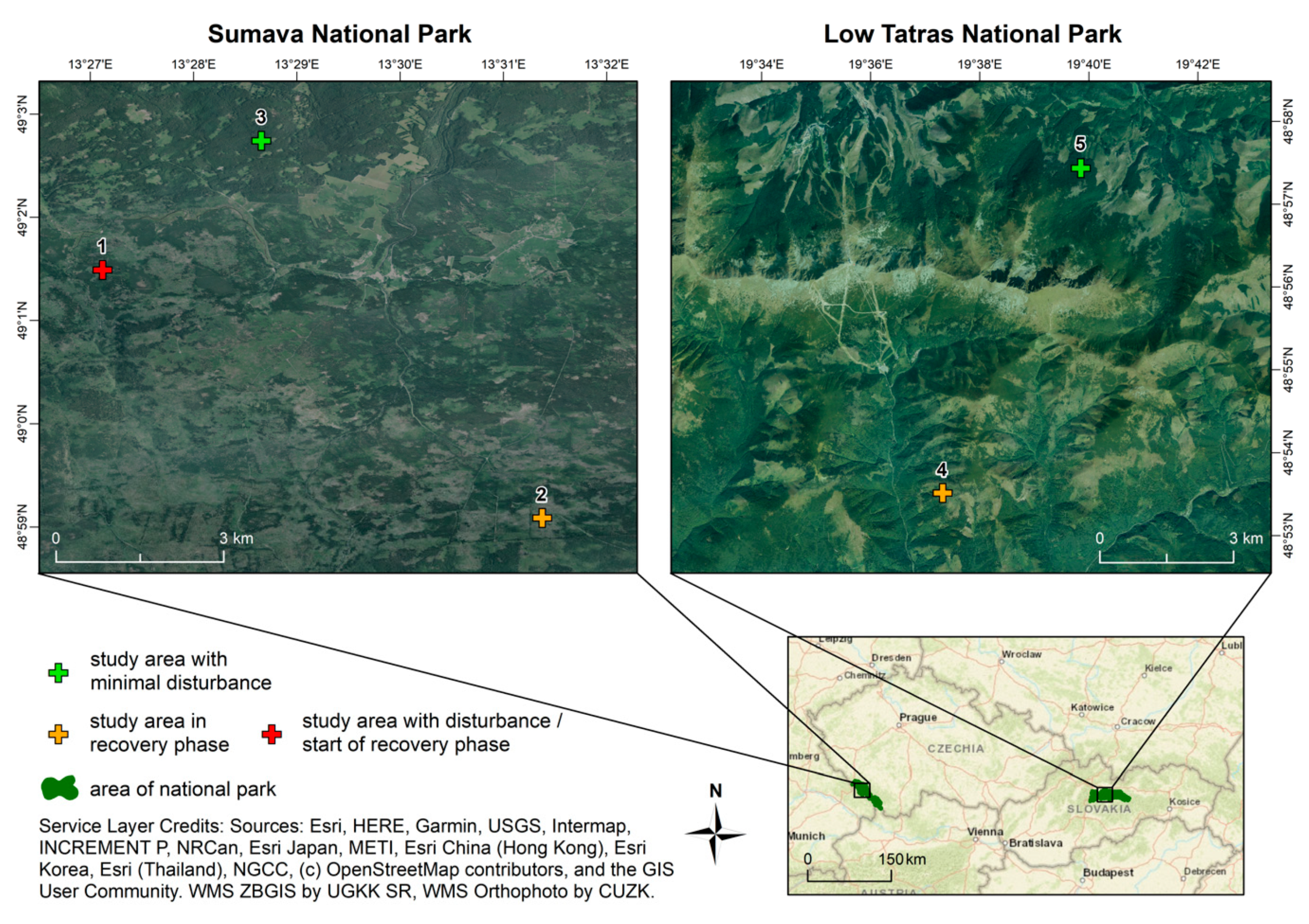
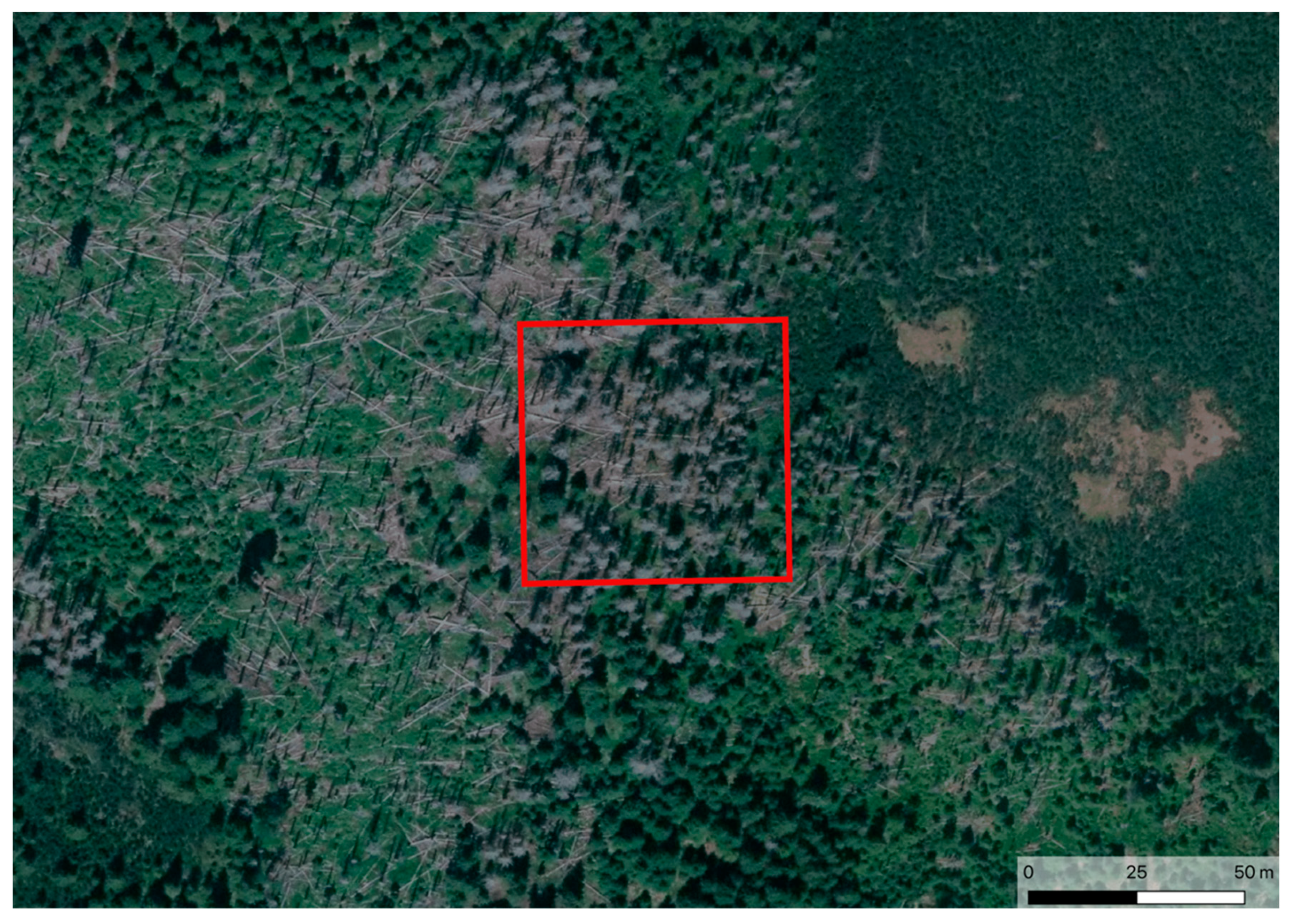
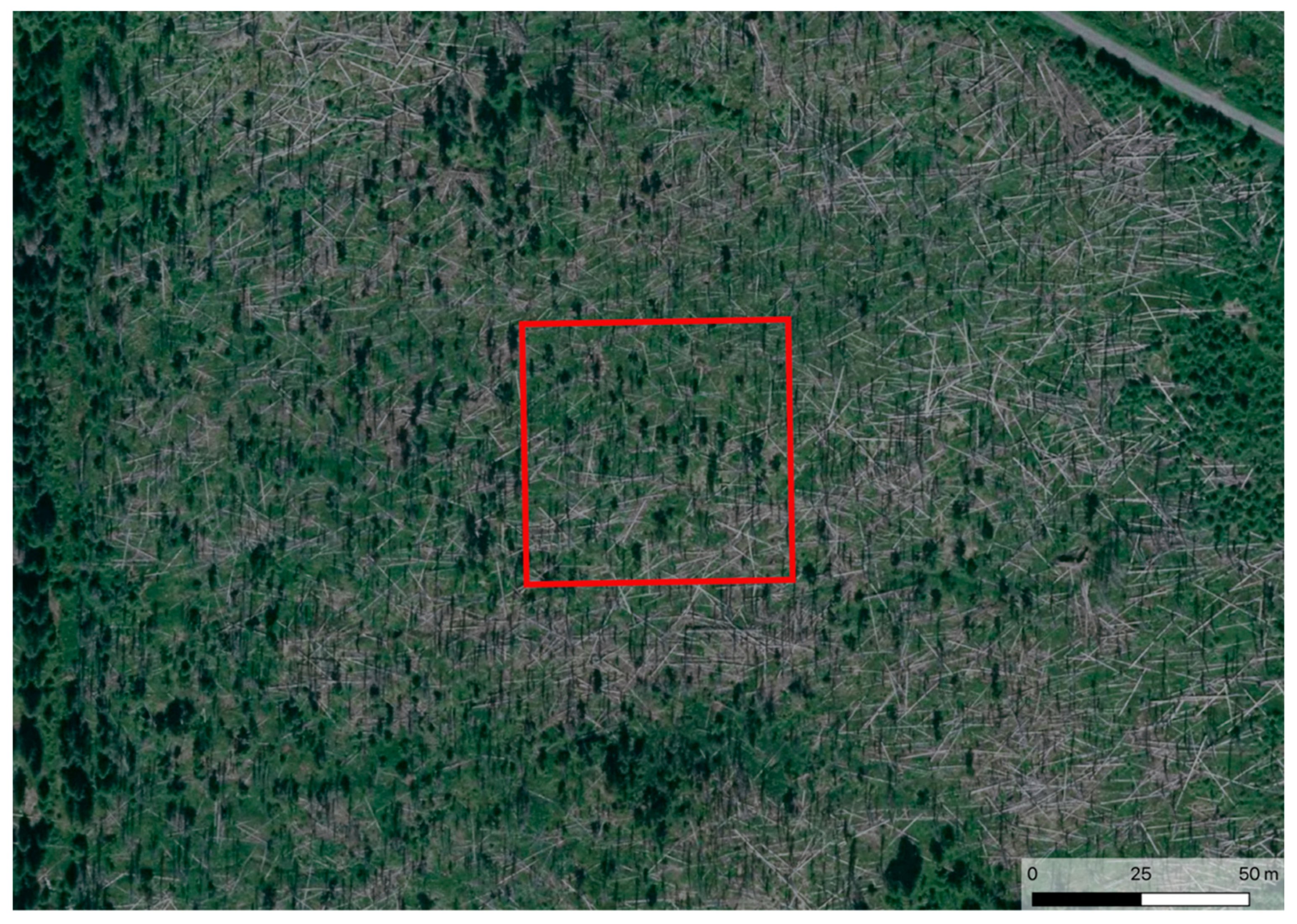
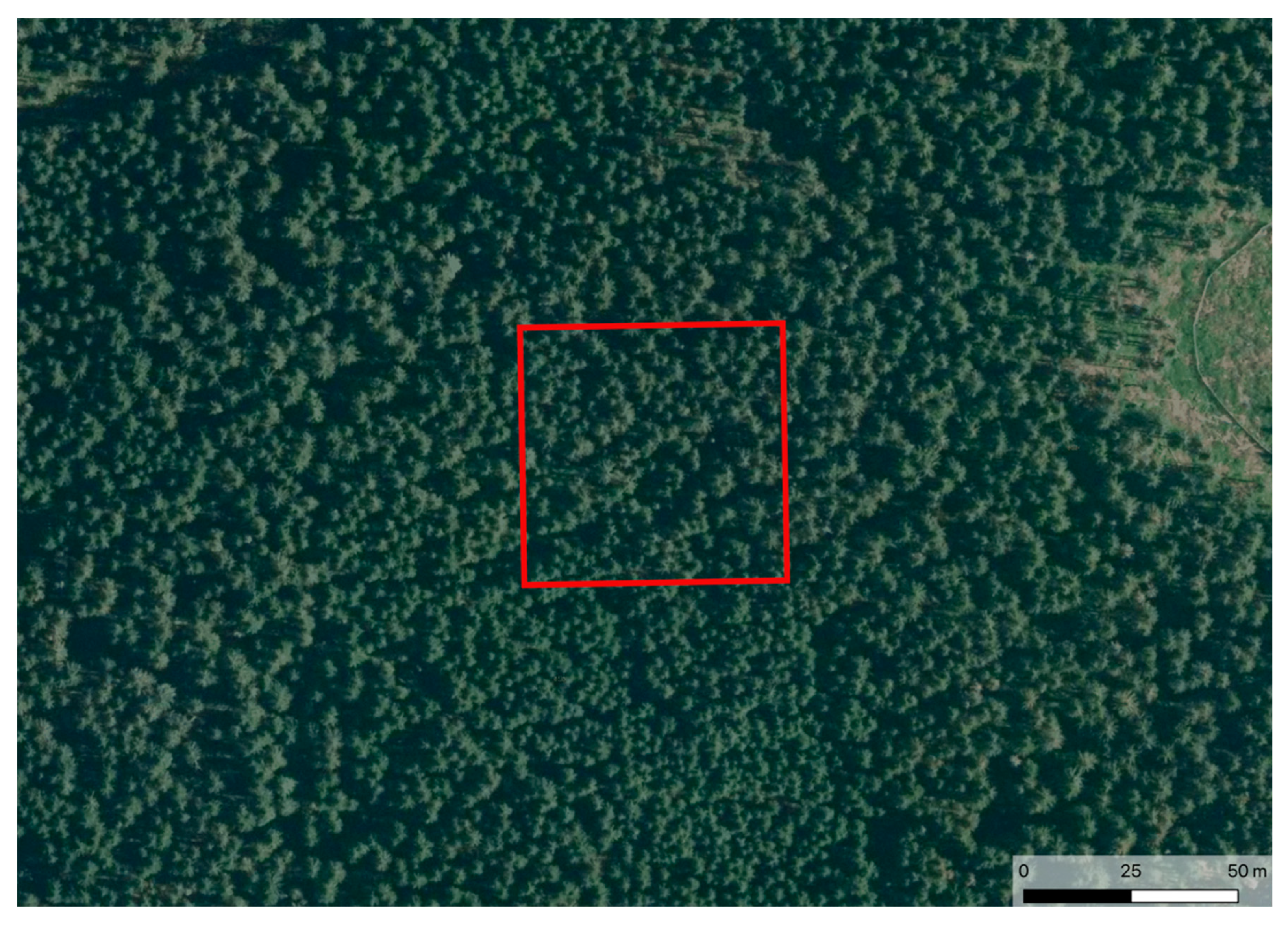
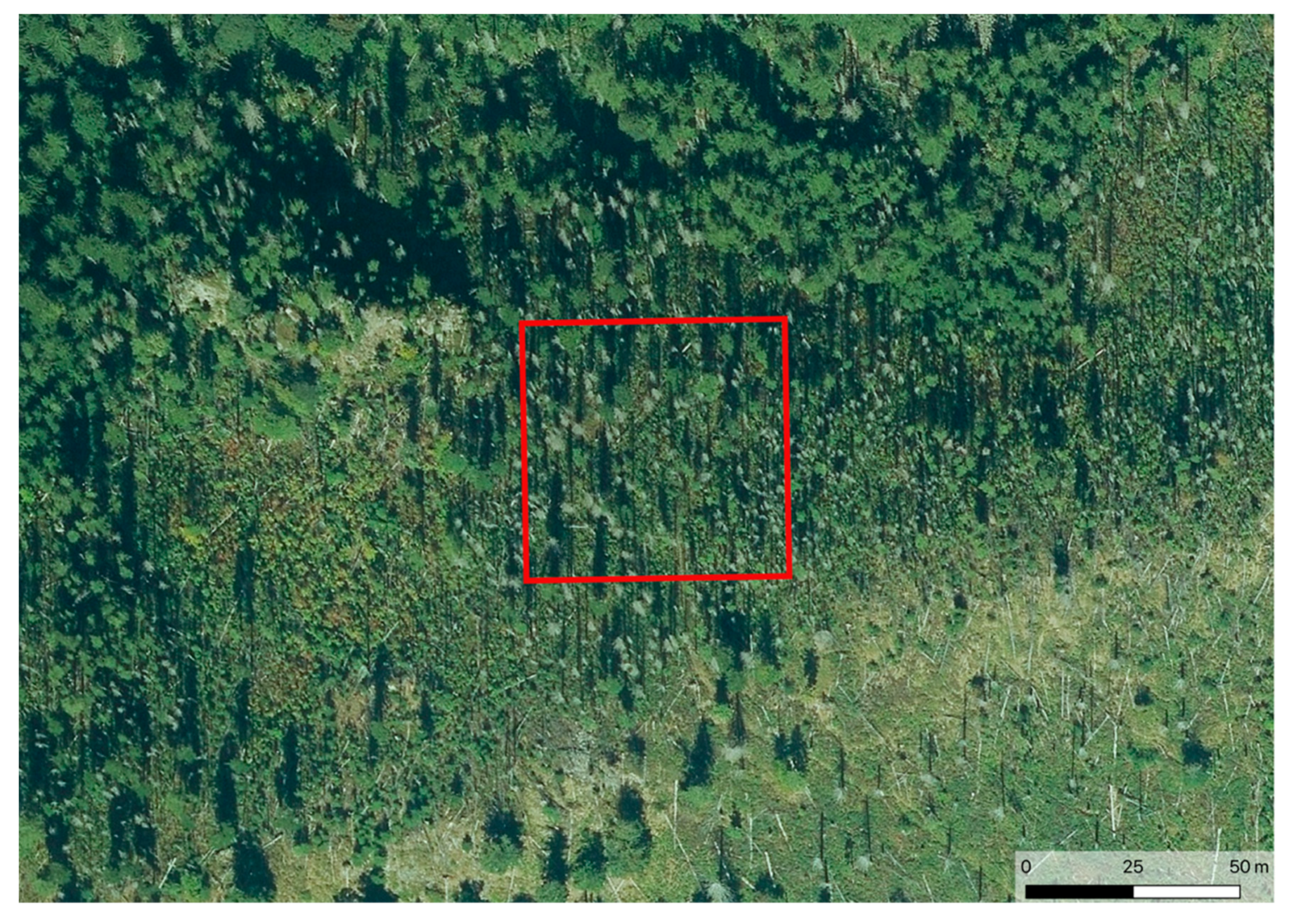
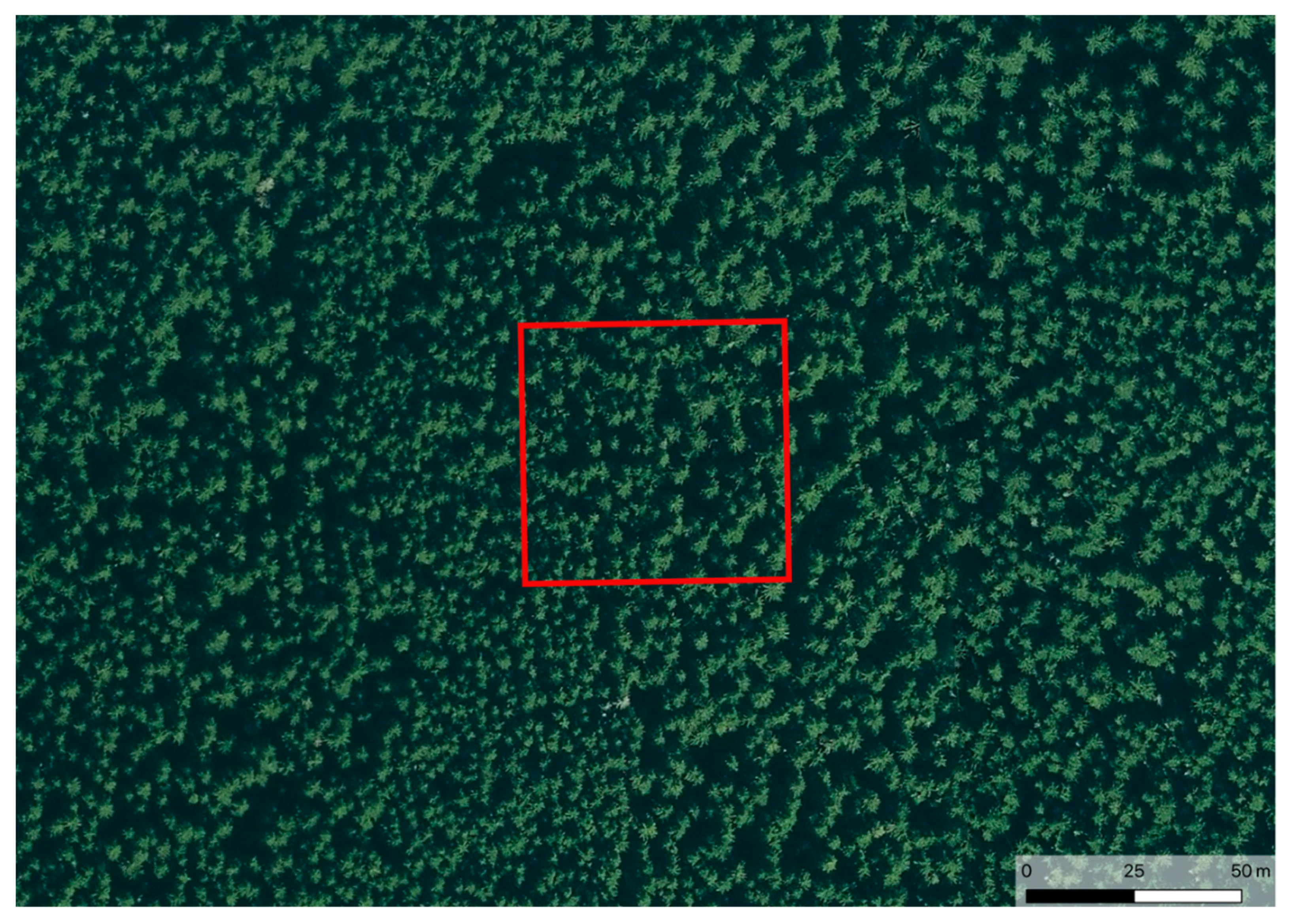
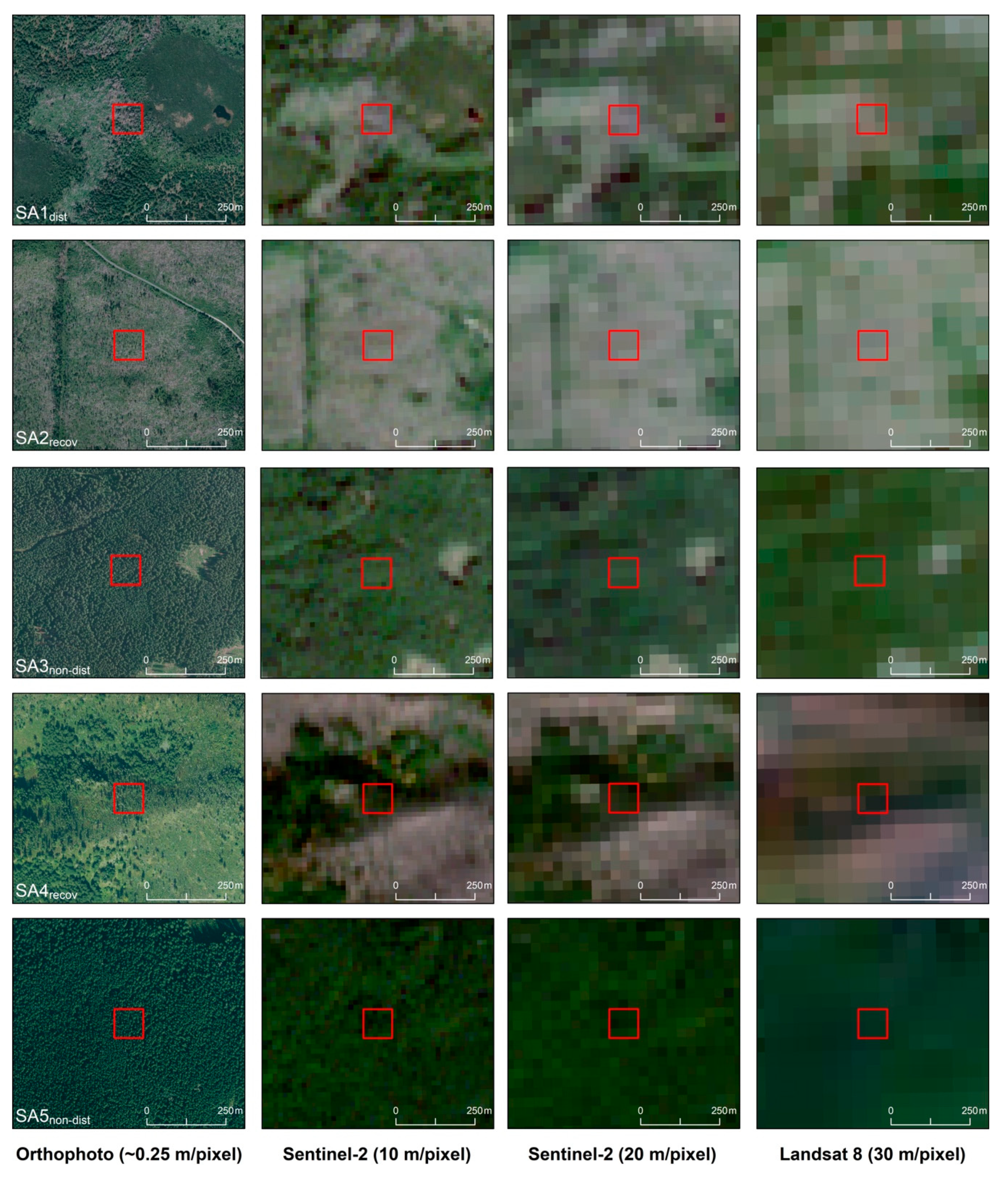



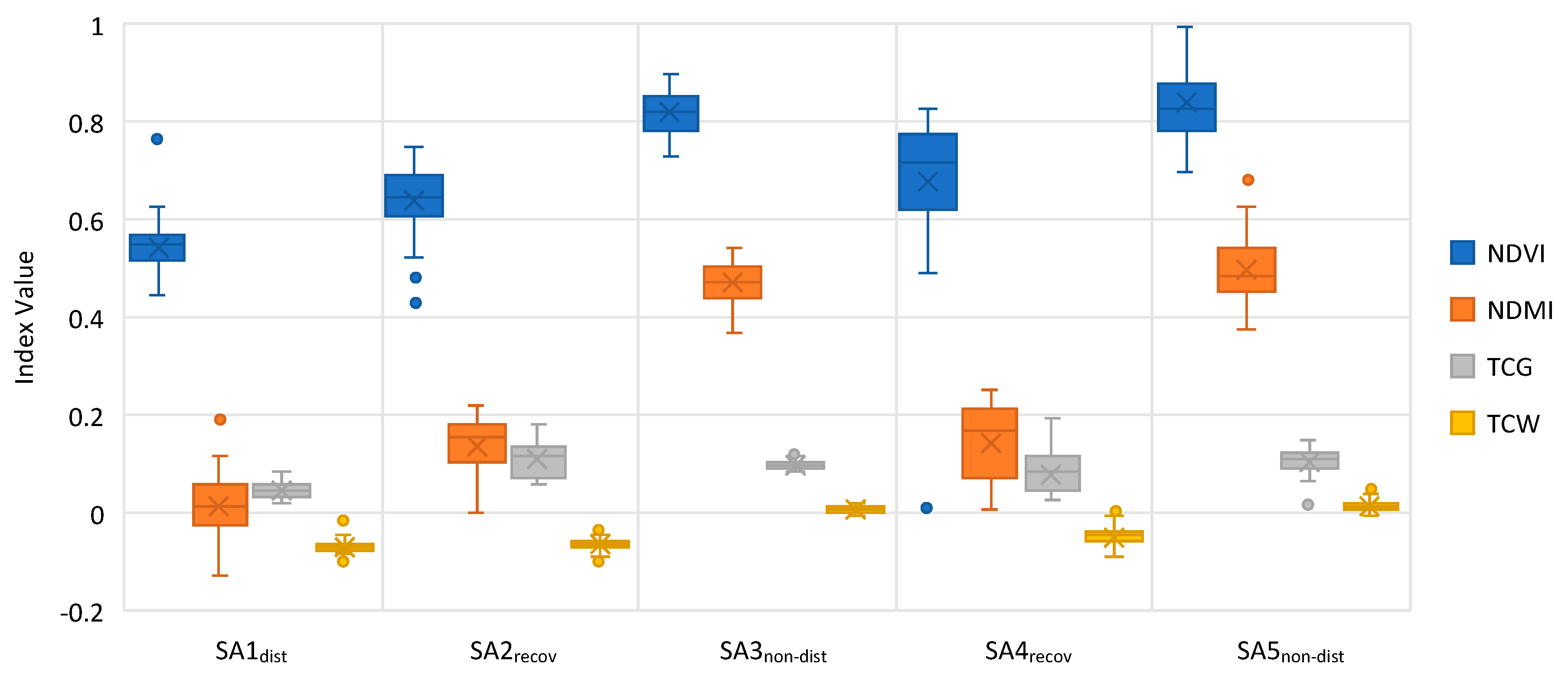
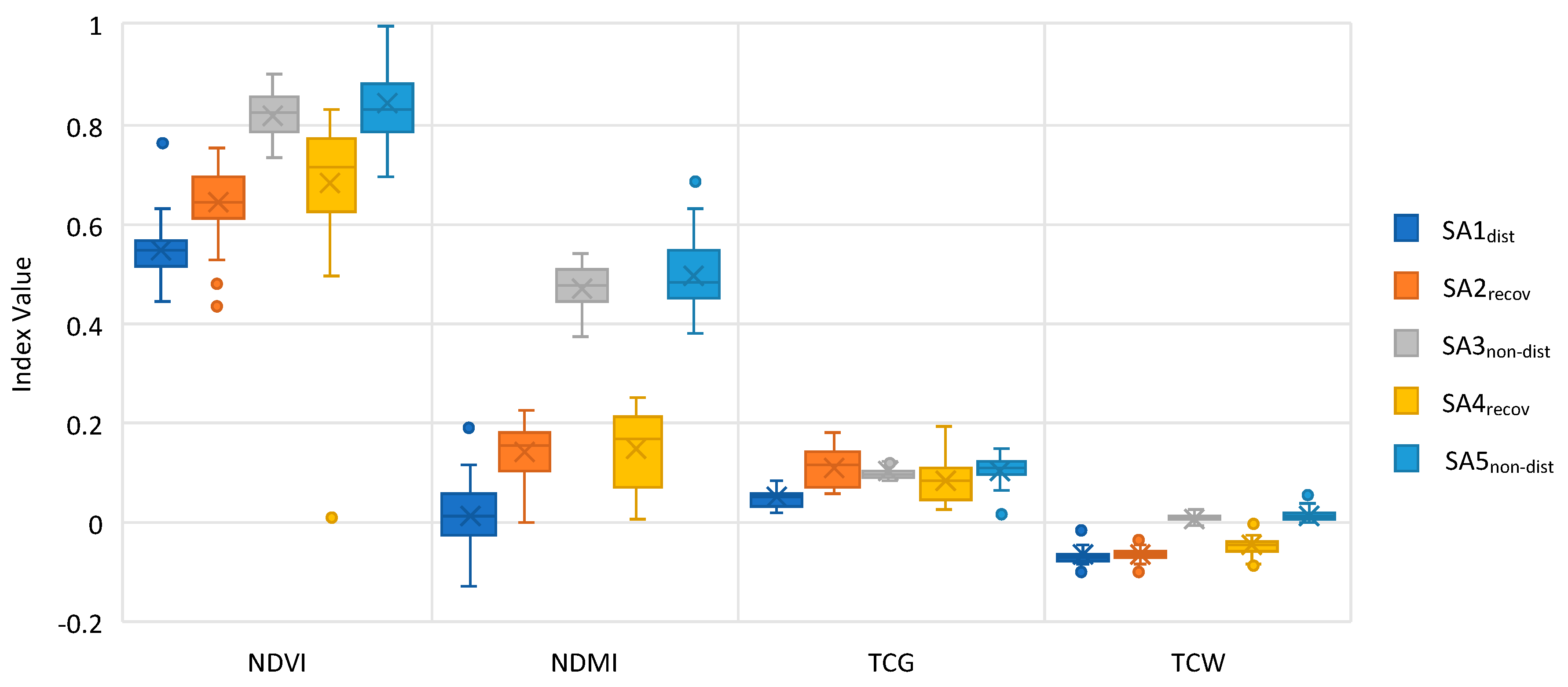
| Study Area | Country (National Park) | Latitude (WGS84) | Longitude (WGS84) | Altitude (m) | Disturbance | Description |
|---|---|---|---|---|---|---|
| SA1dist | Czechia (Sumava National park) | 13.45196 | 49.02482 | 1040 | YES | Bark beetle calamity (red-attack 2015, gray-attack prevailed 2016–2017). From 2018 in the recovery phase. |
| SA2recov | Czechia (Sumava National park) | 13.52290 | 48.98473 | 1160 | YES | Recovery phase after bark beetle calamity. Small spruces and shrubs as undergrowth. |
| SA3non-dist | Czechia (Sumava National park) | 13.47758 | 49.04568 | 1035 | NO | Stable ecosystem with spruce trees, grass and moss as undergrowth. Visible impact of drought in last years. |
| SA4recov | Slovakia (Low Tatras National Park) | 19.61421 | 48.89590 | 1300 | YES | Recovery phase after bark beetle calamity. Small trees and shrubs as undergrowth. |
| SA5non-dist | Slovakia (Low Tatras National Park) | 19.66245 | 48.95963 | 1335 | NO | Stable ecosystem with spruce trees. |
| SA1dist | SA2recov | SA3non-dist | SA4recov | SA5non-dist | Total | |
|---|---|---|---|---|---|---|
| Landsat images available in 2017 | 34 | 35 | 35 | 33 | 33 | 170 |
| Landsat images used in 2017 | 9 | 9 | 8 | 4 | 6 | 36 |
| % of the used images (L8 in 2017) | 26.47 | 25.71 | 22.86 | 12.12 | 18.18 | 21.18 |
| Sentinel images available in 2017 | 41 | 41 | 41 | 78 | 81 | 282 |
| Sentinel images used in 2017 | 7 | 8 | 8 | 12 | 14 | 49 |
| % of the used images (S-2 in 2017) | 17.07 | 19.51 | 19.51 | 15.38 | 17.28 | 17.38 |
| Landsat images available in 2018 | 43 | 45 | 45 | 44 | 44 | 221 |
| Landsat images used in 2018 | 9 | 9 | 12 | 5 | 6 | 41 |
| % of the used images (L8 in 2018) | 20.93 | 20.00 | 26.67 | 11.36 | 13.64 | 18.55 |
| Sentinel images available in 2018 | 73 | 73 | 73 | 140 | 141 | 500 |
| Sentinel images used in 2018 | 16 | 13 | 9 | 14 | 22 | 74 |
| % of the used images (S-2 in 2018) | 21.92 | 17.81 | 12.33 | 10.00 | 15.60 | 14.80 |
| Landsat images available in 2019 | 46 | 46 | 46 | 48 | 48 | 234 |
| Landsat images used in 2019 | 5 | 5 | 6 | 6 | 7 | 29 |
| % of the used images (L8 in 2019) | 10.87 | 10.87 | 13.04 | 12.50 | 14.58 | 12.39 |
| Sentinel images available in 2019 | 71 | 71 | 71 | 144 | 145 | 502 |
| Sentinel images used in 2019 | 10 | 10 | 10 | 11 | 16 | 57 |
| % of the used images (S-2 in 2019) | 14.08 | 14.08 | 14.08 | 7.64 | 11.03 | 11.35 |
| SA1dist | SA2recov | SA3non-dist | SA4recov | SA5non-dist | |
|---|---|---|---|---|---|
| NDVI | 0.057 | 0.070 | 0.044 | 0.140 | 0.076 |
| NDMI | 0.066 | 0.062 | 0.041 | 0.075 | 0.064 |
| TCG | 0.017 | 0.038 | 0.012 | 0.078 | 0.027 |
| TCW | 0.015 | 0.012 | 0.006 | 0.019 | 0.010 |
| SA1dist | SA2recov | SA3non-dist | SA4recov | SA5non-dist | |
|---|---|---|---|---|---|
| NDVI | 0.001383 | 0.023480 | 0.719900 | 0.000001 | 0.003258 |
| NDMI | 0.789300 | 0.044700 | 0.823200 | 0.002179 | 0.378700 |
| TCG | 0.773300 | 0.046910 | 0.004701 | 0.000001 | 0.000703 |
| TCW | 0.010030 | 0.128700 | 0.652100 | 0.131400 | 0.013750 |
| NDVI | NDMI | |||||||||
| SA1dist | SA2recov | SA3non-dist | SA4recov | SA1dist | SA2recov | SA3non-dist | SA4recov | |||
| SA2recov | 2.80 × 10−7 | SA2recov | 2.00 × 10−9 | |||||||
| SA3non-dist | 1.60 × 10−15 | 4.80 × 10−15 | SA3non-dist | <2 × 10−16 | 6.10 × 10−16 | |||||
| SA4recov | 1.60 × 10−9 | 0.023 | 3.40 × 10−8 | SA4recov | 1.10 × 10−9 | 0.510 | <2 × 10−16 | |||
| SA5non-dist | 1.30 × 10−13 | 3.90 × 10−13 | 0.377 | 8.50 × 10−10 | SA5non-dist | 6.30 × 10−14 | 1.70 × 10−13 | 0.190 | 8.40 × 10−15 | |
| TCG | TCW | |||||||||
| SA1dist | SA2recov | SA3non-dist | SA4recov | SA1dist | SA2recov | SA3non-dist | SA4recov | |||
| SA2recov | 2.20 × 10−11 | SA2recov | 0.371 | |||||||
| SA3non-dist | 2.30 × 10−16 | 0.972 | SA3non-dist | 2.30 × 10−16 | 6.90 × 10−16 | |||||
| SA4recov | 0.002 | 0.182 | 0.346 | SA4recov | 3.20 × 10−5 | 1.20 × 10−4 | 1.30 × 10−15 | |||
| SA5non-dist | 5.30 × 10−11 | 0.972 | 0.133 | 0.098 | SA5non-dist | 6.30 × 10−14 | 1.70 × 10−13 | 0.075 | 1.90 × 10−14 | |
© 2020 by the authors. Licensee MDPI, Basel, Switzerland. This article is an open access article distributed under the terms and conditions of the Creative Commons Attribution (CC BY) license (http://creativecommons.org/licenses/by/4.0/).
Share and Cite
Lastovicka, J.; Svec, P.; Paluba, D.; Kobliuk, N.; Svoboda, J.; Hladky, R.; Stych, P. Sentinel-2 Data in an Evaluation of the Impact of the Disturbances on Forest Vegetation. Remote Sens. 2020, 12, 1914. https://doi.org/10.3390/rs12121914
Lastovicka J, Svec P, Paluba D, Kobliuk N, Svoboda J, Hladky R, Stych P. Sentinel-2 Data in an Evaluation of the Impact of the Disturbances on Forest Vegetation. Remote Sensing. 2020; 12(12):1914. https://doi.org/10.3390/rs12121914
Chicago/Turabian StyleLastovicka, Josef, Pavel Svec, Daniel Paluba, Natalia Kobliuk, Jan Svoboda, Radovan Hladky, and Premysl Stych. 2020. "Sentinel-2 Data in an Evaluation of the Impact of the Disturbances on Forest Vegetation" Remote Sensing 12, no. 12: 1914. https://doi.org/10.3390/rs12121914
APA StyleLastovicka, J., Svec, P., Paluba, D., Kobliuk, N., Svoboda, J., Hladky, R., & Stych, P. (2020). Sentinel-2 Data in an Evaluation of the Impact of the Disturbances on Forest Vegetation. Remote Sensing, 12(12), 1914. https://doi.org/10.3390/rs12121914







